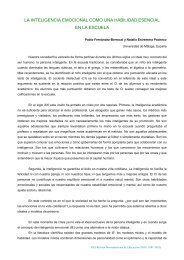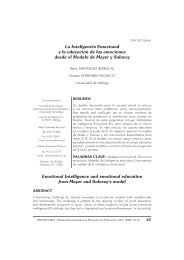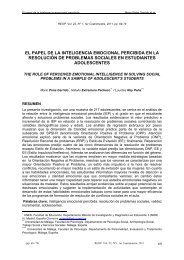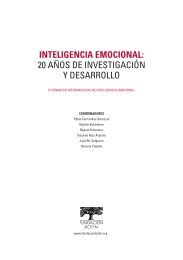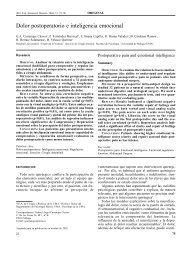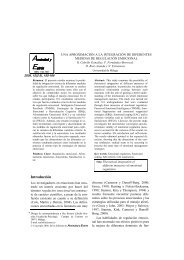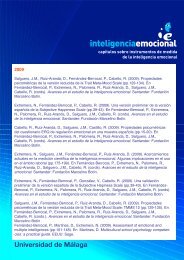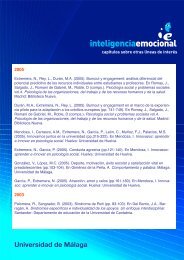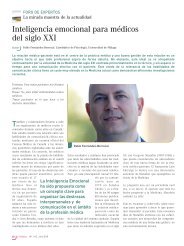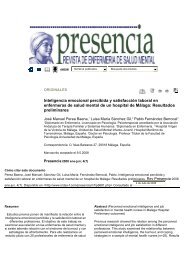Avances en el estudio de la Inteligencia Emocional
Avances en el estudio de la Inteligencia Emocional
Avances en el estudio de la Inteligencia Emocional
You also want an ePaper? Increase the reach of your titles
YUMPU automatically turns print PDFs into web optimized ePapers that Google loves.
Variables no cognitivas y predicción d<strong>el</strong> r<strong>en</strong>dimi<strong>en</strong>to académico<br />
(Dunn & Dunn, 1981) were administered to 11<br />
adolesc<strong>en</strong>ts (M = 15.7) to measure ability EI and verbal<br />
flu<strong>en</strong>cy, respectiv<strong>el</strong>y. The objective was to assess<br />
the in<strong>de</strong>p<strong>en</strong>d<strong>en</strong>t contribution of both types of int<strong>el</strong>lig<strong>en</strong>ce<br />
to the adolesc<strong>en</strong>t’s response to a difficult<br />
social situation. In summary, the authors showed<br />
that stud<strong>en</strong>ts with a high emotional int<strong>el</strong>lig<strong>en</strong>ce<br />
<strong>de</strong>monstrate better and greater emotional organisation<br />
than those with low scores.<br />
Woitaszewski and Aalsman (2004) found that<br />
EI (measured by MEIS-A; Mayer, Salovey, & Caruso,<br />
1997), was in<strong>de</strong>p<strong>en</strong>d<strong>en</strong>t of the social and aca<strong>de</strong>mic<br />
success (measured by the Test of Cognitive Skills;<br />
TCS/2, 1993), in a sample of thirty-nine G&T adolesc<strong>en</strong>ts<br />
(M = 16 years, 6 months). Also, all the stud<strong>en</strong>ts<br />
showed average lev<strong>el</strong>s of EI. In summary, for<br />
future studies the authors pointed out the need to use<br />
complem<strong>en</strong>tary mod<strong>el</strong>s of EI (trait EI and ability EI;<br />
e.g., Baron, 2006; Goleman, 1995; Mayer & Salovey,<br />
1997, Petri<strong>de</strong>s, Pérez-González & Furnham, 2007),<br />
and also the importance of <strong>de</strong>v<strong>el</strong>oping this kind of<br />
research in a natural context in or<strong>de</strong>r to id<strong>en</strong>tify<br />
specific constructs that contribute to successful outcomes<br />
in this popu<strong>la</strong>tion.<br />
Trait mod<strong>el</strong> and G&T stud<strong>en</strong>t<br />
Chan (2003) conducted a research measuring the<br />
259 gifted adolesc<strong>en</strong>ts’ trait EI (M = 13.66; SD =<br />
1.34). This study had a double aim. Firstly, to study<br />
the nature and dim<strong>en</strong>sions of EI based on the responses<br />
of a sample of gifted stud<strong>en</strong>ts. To do this,<br />
a factor analysis on the Emotional Int<strong>el</strong>lig<strong>en</strong>ce Scale<br />
(EIS; Schutte et al., 1998) was carried out. Results<br />
showed a four-factor gifted trait EI structure with<br />
the dim<strong>en</strong>sions: social skills, s<strong>el</strong>f-managem<strong>en</strong>t of<br />
emotions, empathy and utilization of emotions.<br />
This structure was differ<strong>en</strong>t to the three-factor<br />
structure reported by the authors of the instrum<strong>en</strong>t.<br />
Also, gifted stud<strong>en</strong>ts scored higher on the<br />
first two factors, and lower in the two second ones.<br />
Secondly, the study aimed to investigate the<br />
r<strong>el</strong>ation betwe<strong>en</strong> differ<strong>en</strong>t EI compon<strong>en</strong>ts and specific<br />
social coping strategies. To do this, the Social<br />
Coping Questionnaire (SCQ; Swiatek, 1995) was<br />
applied. Results suggested certain links betwe<strong>en</strong><br />
specific compon<strong>en</strong>ts of trait EI and specific social<br />
coping strategies, especially with Valuing peer acceptance<br />
and Involvem<strong>en</strong>t in activities with peers.<br />
These strategies were, at the same time, the most oft<strong>en</strong><br />
employed strategies to cope with being gifted.<br />
Ferrando (2006) studied the differ<strong>en</strong>ces in<br />
trait EI among differ<strong>en</strong>t groups using the EQi: i<br />
YV: 1) high ability vs. average ability, 2) gifted vs.<br />
average ability, 3) tal<strong>en</strong>ted vs. average ability, and 4)<br />
gifted vs. tal<strong>en</strong>ted stud<strong>en</strong>ts. Results showed that all<br />
the groups participating (average stud<strong>en</strong>ts, gifted,<br />
and tal<strong>en</strong>ted), scored high for mood, while scores<br />
were low for interpersonal dim<strong>en</strong>sions; b) the gifted<br />
stud<strong>en</strong>ts scored higher that their peers in all areas in<br />
EI. The differ<strong>en</strong>ces were significant with respect to<br />
non-gifted stud<strong>en</strong>ts in mood, adaptability and<br />
overall EI; c) the tal<strong>en</strong>ted group scored statistically<br />
higher than those average ability stud<strong>en</strong>ts in stress<br />
managem<strong>en</strong>t, intrapersonal r<strong>el</strong>ations, and overall<br />
EI; d) no statistically significant differ<strong>en</strong>ces were<br />
found betwe<strong>en</strong> gifted vs. tal<strong>en</strong>ted stud<strong>en</strong>ts.<br />
Schewean, Saklofske, Widdifi<strong>el</strong>d-Konkin,<br />
Parker, and Kloosterman (2006) studied the socioemotional<br />
compet<strong>en</strong>ces of gifted (N = 169) and<br />
non-gifted (N = 1200) stud<strong>en</strong>ts (M = 11.45; SD =<br />
1.10), and the congru<strong>en</strong>ce betwe<strong>en</strong> s<strong>el</strong>f-ratings and<br />
ratings by par<strong>en</strong>ts and teachers. Wh<strong>en</strong> the EQ-i: YV<br />
(Bar-On & Parker, 2000) was administered, gifted<br />
stud<strong>en</strong>ts showed a higher s<strong>el</strong>f-perception about<br />
their emotional compet<strong>en</strong>ces than their non-gifted<br />
counterparts, especially in terms of the intrapersonal<br />
and adaptability dim<strong>en</strong>sions. However, non-gifted<br />
scored higher than gifted in the interpersonal<br />
dim<strong>en</strong>sion. Also, gifted stud<strong>en</strong>ts’ par<strong>en</strong>ts perceived<br />
their childr<strong>en</strong> as being more emotionally int<strong>el</strong>lig<strong>en</strong>t<br />
than non-gifted stud<strong>en</strong>ts’ par<strong>en</strong>ts did for their<br />
childr<strong>en</strong>, especially in adaptability, stress<br />
managem<strong>en</strong>t and total scores.<br />
Regarding the congru<strong>en</strong>ce betwe<strong>en</strong> s<strong>el</strong>f-ratings<br />
and ratings by par<strong>en</strong>ts and teachers in the gifted<br />
sample, all the ratings were inter-corr<strong>el</strong>ated across the<br />
same dim<strong>en</strong>sion (i.e., intrapersonal dim<strong>en</strong>sion<br />
betwe<strong>en</strong> stud<strong>en</strong>ts’ and par<strong>en</strong>ts’ ratings; interpersonal<br />
dim<strong>en</strong>sions betwe<strong>en</strong> par<strong>en</strong>ts’ and teacher’s ratings,<br />
and so on). Ev<strong>en</strong> so, the corr<strong>el</strong>ation was not as high<br />
as was expected by the authors (p < .05, for all the<br />
cases). Also, gifted stud<strong>en</strong>ts have shown a lower s<strong>el</strong>fperception<br />
about their socio-emotional skills than<br />
their par<strong>en</strong>ts and teachers had indicated in all the<br />
dim<strong>en</strong>sions and the global score. Schewean et al.,<br />
(2006) found that s<strong>el</strong>f-ratings were slightly lower<br />
than those giv<strong>en</strong> by both par<strong>en</strong>ts and teachers in all<br />
the cases (i.e., ratings by teachers and par<strong>en</strong>ts on the<br />
interpersonal scale were significantly higher than<br />
s<strong>el</strong>f-report ratings on this scale)<br />
470



